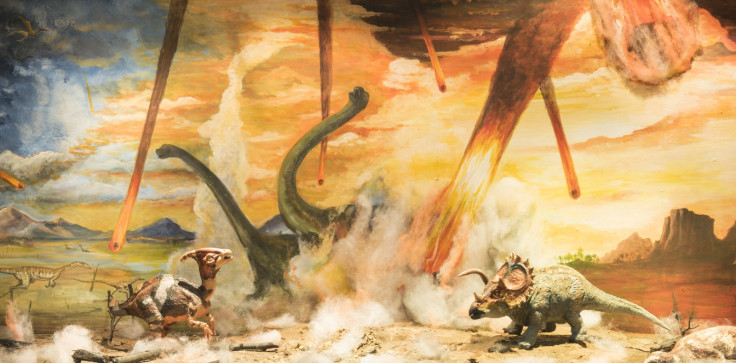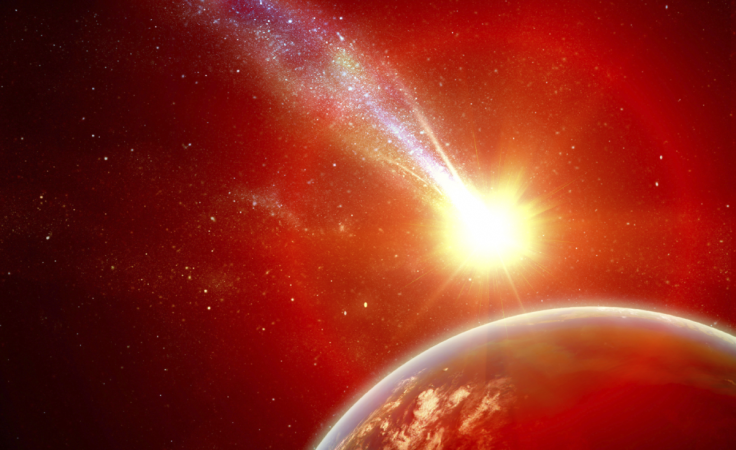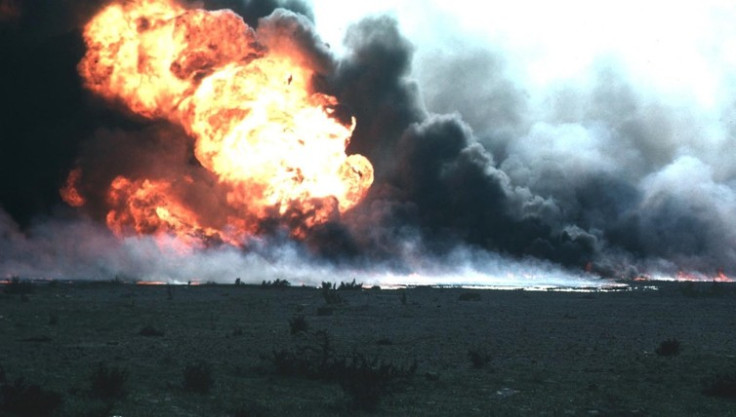Did a burning oil spill wipe out the dinosaurs?
Asteroid impact would have burned huge oil reserves, potentially blocking 90% of the sun for years.

Nick Longrich, University of Bath
Sixty six million years ago, the dinosaurs suddenly disappeared, along with most of the species on the planet. The extinction occurred at precisely the same time that a giant asteroid struck the Earth. The fact that the two events happened at the same time makes it all but certain that the asteroid wiped out the dinosaurs, but just how did that extinction happen? Was it dust, shot into the sky, blocking out the sun? Acid rain produced by sulphur vaporised during the impact? An inferno of hot debris?
A new study may get us closer to solving this mystery. The asteroid struck the Yucatan Peninsula, a region with vast quantities of crude oil buried underground. New data shows that the burning of the oil produced billions of tons of soot, enough to dim the sun for years and lead to a decade of global cooling.
The Cretaceous-Paleogene (K-Pg) extinction event was severe, wiping out over 75% of all species, including not just dinosaurs but also many birds, mammals, snakes, lizards, plants, and even insects. It was global, hitting all continents and all oceans. And it was rapid, with species seeming to vanish overnight.

In 1979, physicist Luis Alvarez was trying to figure out just how much time the extinction took. He focused on a thin layer of clay – the K-Pg boundary – that marked the extinction. His clever idea was to look at iridium levels in the boundary clay. Iridium is a rare metal found primarily in meteorites, so the slow trickle of iridium from meteorites burning up in the atmosphere should act as a sort of cosmic hourglass, telling the passing of time.
His plan backfired spectacularly: iridium levels in the clay were orders of magnitude above the normal background levels. The K-Pg boundary was the debris of a giant asteroid impact. A few calculations suggested that it would take an asteroid 10 kilometres across to produce all that iridium. The idea that an asteroid wiped out the dinosaurs was widely ridiculed – but then, in 1990, the giant Chicxulub crater in Mexico was discovered.
Global extinction
But how does an asteroid impact in Mexico cause a worldwide extinction? Alvarez read about the 1815 explosion of Tamboro. Sulphate gas shot into the atmosphere caused a volcanic haze that reflected sunlight. It lead to the "Year Without a Summer", when freezing temperatures in summer lead to widespread crop failures and famine. Alvarez proposed that debris from Chicxulub had blocked out the sun. Without the sun, plants and plankton couldn't make food and the entire ecosystem starved.
It was a clever idea but studies of the K-Pg boundary revealed a problem. The debris was mostly coarse and would have dropped out out of the sky in a matter of a few months or weeks – not long enough to starve giant dinosaurs. There wasn't enough fine debris that could stay aloft for years to cause an extinction. So what did?

A new study by Kunio Kaiho and colleagues published in the journal Scientific Reports suggests a possible explanation. The K-Pg boundary contains soot. Although originally thought to be produced by wildfires, studies of its chemistry suggest that it is actually derived from burning hydrocarbons (crude oil). This fact seems puzzling until you consider that the Gulf of Mexico contains vast oil reserves. The Jurassic Cantarell oil field, the largest in Mexico, is nearby and, in fact, the Chicxulub crater was only discovered because geologists were mapping the area in search of oil.
As the Chicxulub asteroid tore into the earth, it released the oil locked in the rock. The Deepwater Horizon spill produced 4.9 million barrels of oil from just a tiny hole in the ocean floor. The Chicxulub crater was 180 kilometers across. The intense heat of the impact would have burned the oil to create clouds of black soot and shot them into the stratosphere. Critically, tiny soot particles can stay up in the atmosphere for years. But was there enough to block out the sun?
The researchers from Tohoku University in Japan studied the chemistry of soot at the K-Pg boundary and then estimated the amount of soot produced by impact. The total burned carbon produced was on the order of 1.8 to 60 billion tons.
Dark and cold
They then used computer models to estimate the effects on the climate. Their models showed that the soot would have been highly effective in blocking light. Depending on the amount of soot, sunlight would have been reduced by 50% to 90%, and the global temperature would have cooled by between 6°C and 18°C, with cooling being especially severe towards the poles. Cooler temperatures would have also reduced rainfall, leading to widespread drought.
Critically, the soot cloud would stay aloft for years. The darkness and cooling were most severe in the first few years, but it would have taken a decade for light levels to slowly return to normal, and even longer for the climate to return to normal.
The research also helps put a time limit on the dinosaur extinction, suggesting the bulk of it took place in a span of less than ten years.
It's probably too soon to say that we have definitively solved the extinction puzzle. Science is rarely that neat and tidy. The nature of science is that, at best, we need to run more analyses and collect more data to confirm new finds, and at worst, it's full of seemingly promising dead ends.
But the new study is one of the most exciting developments in years, and it suggests that we may be closer to finally understanding the extinction of the dinosaurs. It may be that their extinction was caused by pollution and climate change caused by burning oil.
This could also explain why other asteroid impacts aren't associated with mass extinctions. It may have been the unlucky coincidence of a huge oil field and a giant asteroid impact that made Chicxulub so deadly. And there is a certain irony in the possibility that the same oil that did in the dinosaurs is now being used to run our own civilization – and perhaps threatening it as well.
Nick Longrich, Senior lecturer, palaeontology, Milner Centre for Evolution, University of Bath
This article was originally published on The Conversation. Read the original article.
© Copyright IBTimes 2025. All rights reserved.





















